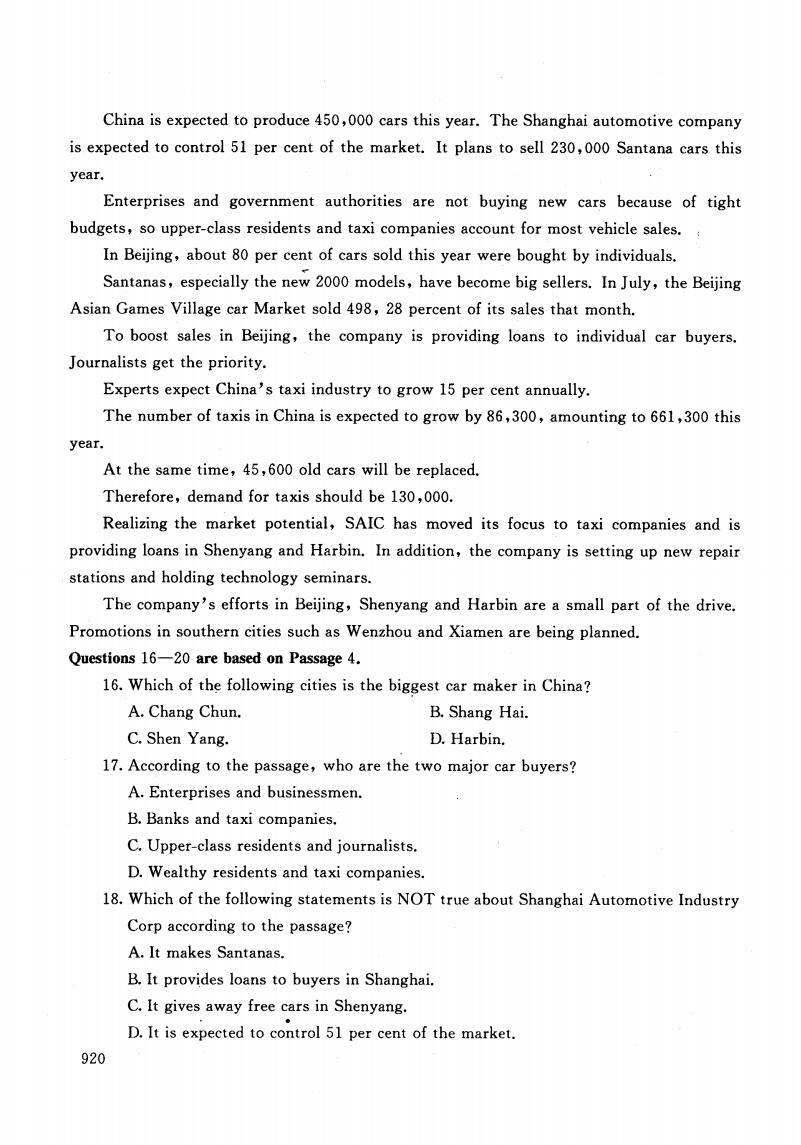正在加载图片...

China is expected to produce 450,000 cars this year.The Shanghai automotive company is expected to control 51 per cent of the market.It plans to sell 230,000 Santana cars this year. Enterprises and government authorities are not buying new cars because of tight budgets,so upper-class residents and taxi companies account for most vehicle sales. In Beijing,about 80 per cent of cars sold this year were bought by individuals. Santanas,especially the new 2000 models,have become big sellers.In July,the Beijing Asian Games Village car Market sold 498,28 percent of its sales that month. To boost sales in Beijing,the company is providing loans to individual car buyers. Journalists get the priority. Experts expect China's taxi industry to grow 15 per cent annually. The number of taxis in China is expected to grow by 86,300,amounting to 661,300 this year. At the same time,45,600 old cars will be replaced. Therefore,demand for taxis should be 130,000. Realizing the market potential,SAIC has moved its focus to taxi companies and is providing loans in Shenyang and Harbin.In addition,the company is setting up new repair stations and holding technology seminars. The company's efforts in Beijing,Shenyang and Harbin are a small part of the drive. Promotions in southern cities such as Wenzhou and Xiamen are being planned. Questions 16-20 are based on Passage 4. 16.Which of the following cities is the biggest car maker in China? A.Chang Chun. B.Shang Hai. C.Shen Yang. D.Harbin. 17.According to the passage,who are the two major car buyers? A.Enterprises and businessmen. B.Banks and taxi companies. C.Upper-class residents and journalists. D.Wealthy residents and taxi companies. 18.Which of the following statements is NOT true about Shanghai Automotive Industry Corp according to the passage? A.It makes Santanas. B.It provides loans to buyers in Shanghai. C.It gives away free cars in Shenyang. D.It is expected to control 51 per cent of the market. 920China is expected to produce 450,000 cars this year. The Shanghai automotive company is expected to control 51 per cent of the market. It plans to sell 230,000 Santana cars this year. Enterprises and government authorities are not buying new cars because of tight budgets, so upper-class residents and taxi companies account for most vehicle sales. In Beijing, about 80 per cent of cars sold this year were bought by individuals. Santanas,especially the new 2000 models, have become big sellers. In July, the Beijing Asian Games Village car Market sold 498,28 percent of its sales that month. To boost sales in Beijing, the company is providing loans to individual car buyers. Journalists get the priority. Experts expect China's taxi industry to grow 15 per cent annually. The number of taxis in China is expected to grow by 86,300,amounting to 661, 300 this year. At the same time, 45,600 old cars will be replaced. Therefore, demand for taxis should be 130,000. Realizing the market potential, SAIL has moved its focus to taxi companies and is providing loans in Shenyang and Harbin. In addition, the company is setting up new repair stations and holding technology seminars. The company's efforts in Beijing, Shenyang and Harbin are a small part of the drive. Promotions in southern cities such as Wenzhou and Xiamen are being planned. Questions 16-20 are based on Passage 4. 16.Which of the following cities is the biggest car maker in China? A. Chang Chun. B. Shang Hai. C. Shen Yang. D. Harbin. 17.According to the passage, who are the two major car buyers? A. Enterprises and businessmen. B. Banks and taxi companies. C. Upper-class residents and journalists. D. Wealthy residents and taxi companies. 18.Which of the following statements is NOT true about Shanghai Automotive Industry Corp according to the passage? A. It makes Santanas. B. It provides loans to buyers in Shanghai. C. It gives away freecars in Shenyang. D. It is expected to control 51 per cent of the market. 920